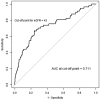Contrast-Induced Acute Kidney Injury in Radiologic Management of Acute Ischemic Stroke in the Emergency Setting
- PMID: 32165364
- PMCID: PMC7144631
- DOI: 10.3174/ajnr.A6472
Contrast-Induced Acute Kidney Injury in Radiologic Management of Acute Ischemic Stroke in the Emergency Setting
Abstract
Background and purpose: The use of invasive cerebral angiography with CTA for active treatment of patients with suspected ischemic strokes has been increasing recently. This study aimed to identify the incidence of postcontrast acute kidney injury using baseline renal function when CTA and cerebral angiography were performed sequentially.
Materials and methods: This retrospective observational study evaluated adults (18 years of age or older) with ischemic stroke who underwent CTA and cerebral angiography sequentially between 2010 and 2018. The incidence of postcontrast acute kidney injury was determined using the baseline estimated glomerular filtration rate. The value of the baseline estimated glomerular filtration rate at which the occurrence of postcontrast acute kidney injury increased was also determined.
Results: Postcontrast acute kidney injury occurred in 57/601 (9.5%) patients. Those with a baseline estimated glomerular filtration rate of <30 mL/min/1.73 m2 showed a higher incidence of acute kidney injury. Age, chronic kidney disease, medication (nonsteroidal anti-inflammatory drugs, angiotensin-converting enzyme inhibitors, angiotensin II receptor blockers, β blockers, statins, and insulin) use following contrast media exposure, and serum albumin affected the incidence of postcontrast acute kidney injury. The incidence of postcontrast acute kidney injury increased when the baseline estimated glomerular filtration rate was <43 mL/min/1.73 m2.
Conclusions: Patients with low baseline renal function had the highest incidence of postcontrast acute kidney injury after CTA and cerebral angiography, but no fatal adverse effects were documented. Thus, patients suspected of having a stroke should be actively managed with respect to neurovascular function.
© 2020 by American Journal of Neuroradiology.
Figures


Comment in
-
Save the Brain First: CTA and Mechanical Thrombectomy in Patients at Risk for Contrast-Induced Nephropathy.AJNR Am J Neuroradiol. 2020 Apr;41(4):637-638. doi: 10.3174/ajnr.A6515. Epub 2020 Mar 26. AJNR Am J Neuroradiol. 2020. PMID: 32217552 Free PMC article. No abstract available.
Similar articles
-
Postcontrast Acute Kidney Injury After Computed Tomography Pulmonary Angiography for Acute Pulmonary Embolism.J Emerg Med. 2019 Dec;57(6):798-804. doi: 10.1016/j.jemermed.2019.09.006. Epub 2019 Nov 15. J Emerg Med. 2019. PMID: 31740158
-
Effect of renin-angiotensin-system blockers on contrast-medium-induced acute kidney injury after coronary angiography.Korean J Intern Med. 2014 Mar;29(2):203-9. doi: 10.3904/kjim.2014.29.2.203. Epub 2014 Feb 27. Korean J Intern Med. 2014. PMID: 24648803 Free PMC article.
-
Risk of Acute Kidney Injury with Consecutive, Multidose Use of Iodinated Contrast in Patients with Acute Ischemic Stroke.AJNR Am J Neuroradiol. 2019 Apr;40(4):652-654. doi: 10.3174/ajnr.A5959. Epub 2019 Jan 24. AJNR Am J Neuroradiol. 2019. PMID: 30679214 Free PMC article.
-
Preventing contrast medium-induced acute kidney injury : Side-by-side comparison of Swedish-ESUR guidelines.Eur Radiol. 2018 Dec;28(12):5384-5395. doi: 10.1007/s00330-018-5678-6. Epub 2018 Aug 21. Eur Radiol. 2018. PMID: 30132106
-
Effect of renin-angiotensin system blockers on contrast-induced acute kidney injury in patients with normal or mild-to-moderate reduced kidney function undergoing coronary angiography: A systematic review and meta-analysis.Clin Nephrol. 2020 Nov;94(5):227-236. doi: 10.5414/CN110171. Clin Nephrol. 2020. PMID: 32870151
Cited by
-
Perfusion Parameter Map Generation from 3 Phases of Computed Tomography Perfusion in Stroke Using Generative Adversarial Networks.Research (Wash D C). 2025 Apr 30;8:0689. doi: 10.34133/research.0689. eCollection 2025. Research (Wash D C). 2025. PMID: 40308708 Free PMC article.
-
Risk factors of acute kidney injury during hospitalization in acute ischaemic stroke patients undergoing mechanical thrombectomy.Postepy Kardiol Interwencyjnej. 2024 Mar;20(1):89-94. doi: 10.5114/aic.2024.136374. Epub 2024 Mar 15. Postepy Kardiol Interwencyjnej. 2024. PMID: 38616933 Free PMC article.
-
Baseline eGFR cutoff for increased risk of post-contrast acute kidney injury in patients undergoing percutaneous coronary intervention for ST-elevation myocardial infarction in the emergency department.PLoS One. 2023 Oct 26;18(10):e0293598. doi: 10.1371/journal.pone.0293598. eCollection 2023. PLoS One. 2023. PMID: 37883518 Free PMC article.
-
Collateral estimation by susceptibility-weighted imaging and prediction of functional outcomes after acute anterior circulation ischemic stroke.Sci Rep. 2021 Nov 1;11(1):21370. doi: 10.1038/s41598-021-00775-9. Sci Rep. 2021. PMID: 34725373 Free PMC article.
-
Changes in blood and renal function in patients after cerebral digital subtraction angiography.Res Diagn Interv Imaging. 2023 Sep 1;7:100032. doi: 10.1016/j.redii.2023.100032. eCollection 2023 Sep. Res Diagn Interv Imaging. 2023. PMID: 39077152 Free PMC article.
References
-
- Powers WJ, Rabinstein AA, Ackerson T, et al. ; American Heart Association Stroke Council. 2018 guidelines for the early management of patients with acute ischemic stroke: a guideline for healthcare professionals from the American Heart Association/American Stroke Association. Stroke 2018;49:e46–110 10.1161/STR.0000000000000158 - DOI - PubMed
Publication types
MeSH terms
Substances
LinkOut - more resources
Full Text Sources
Medical
